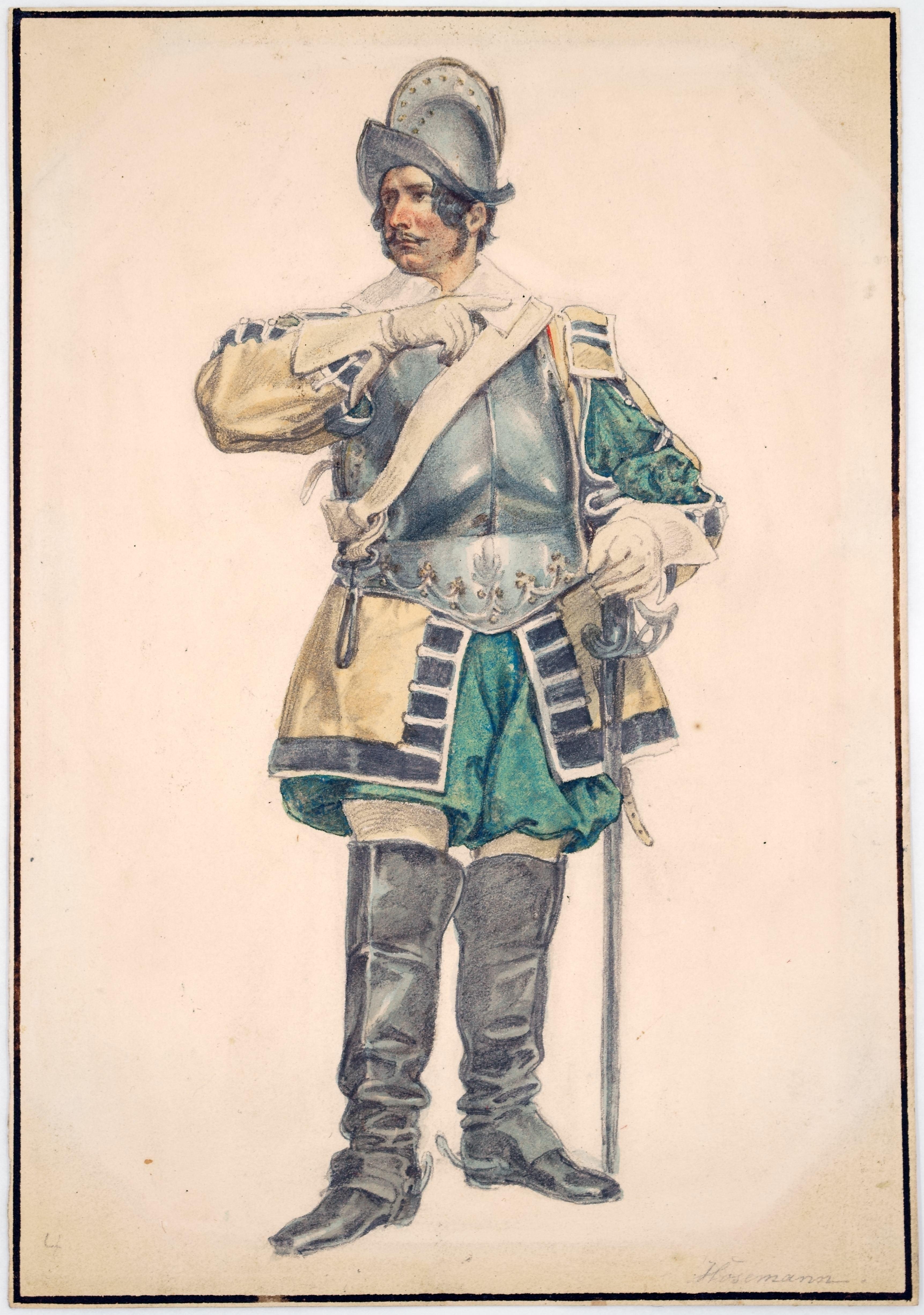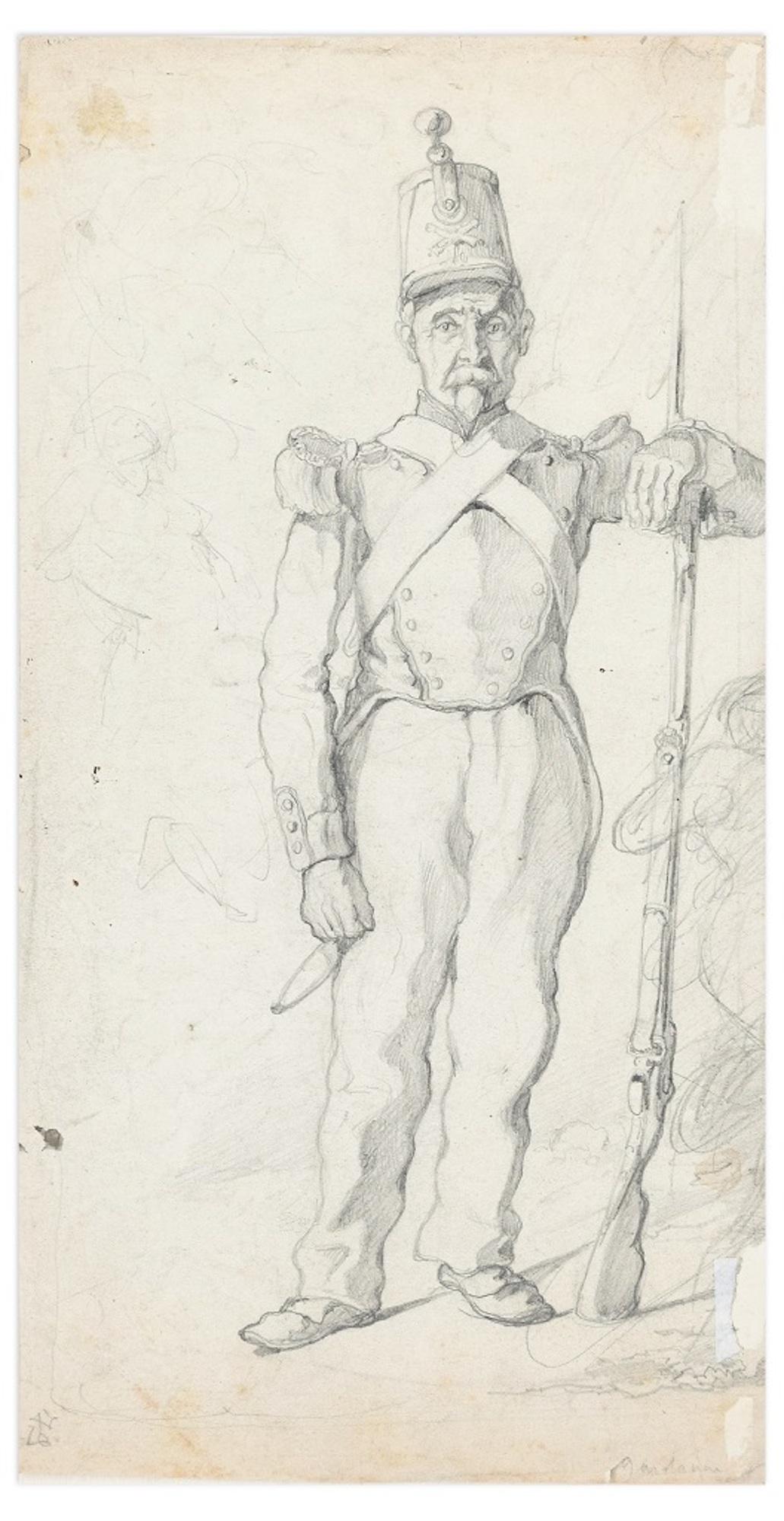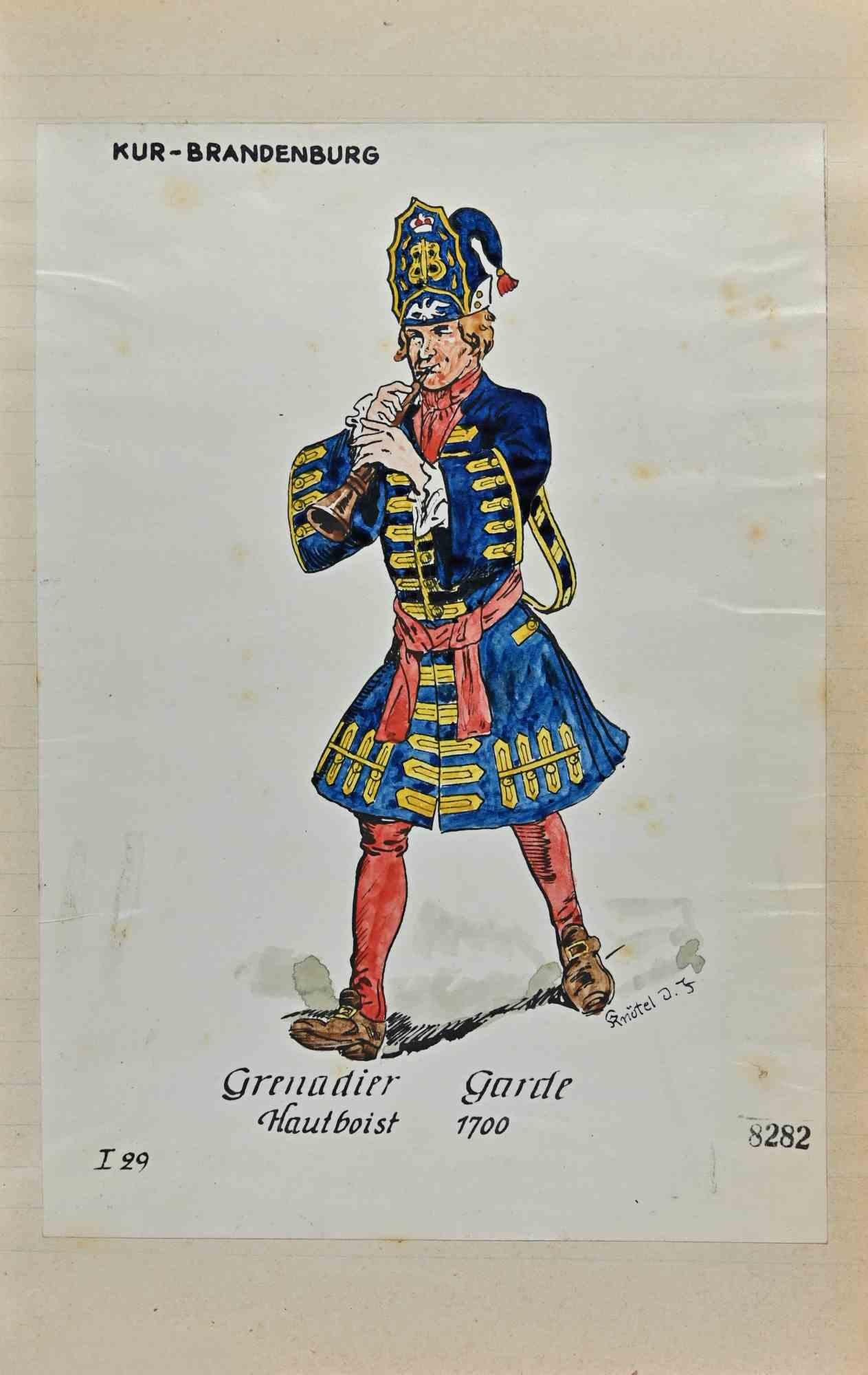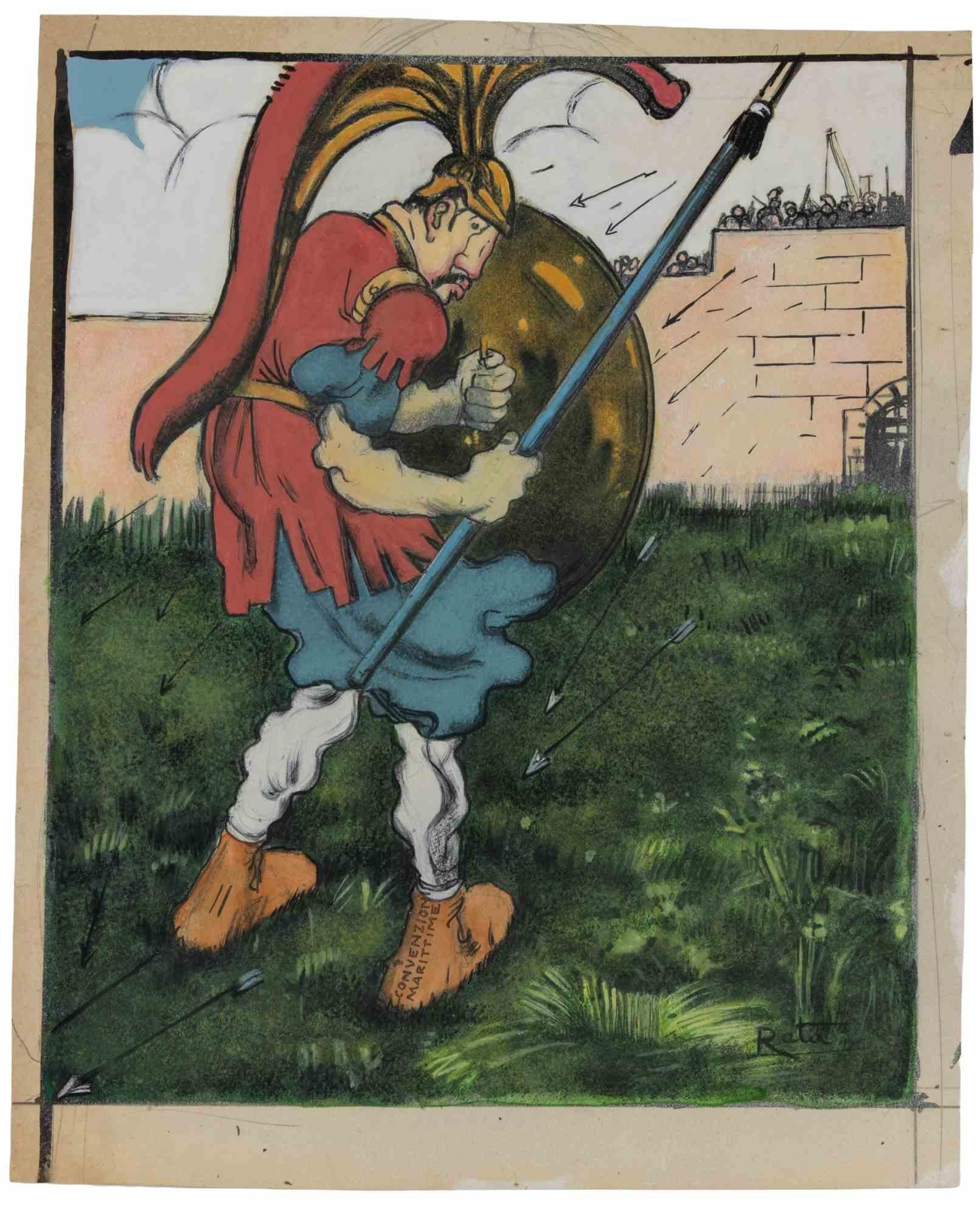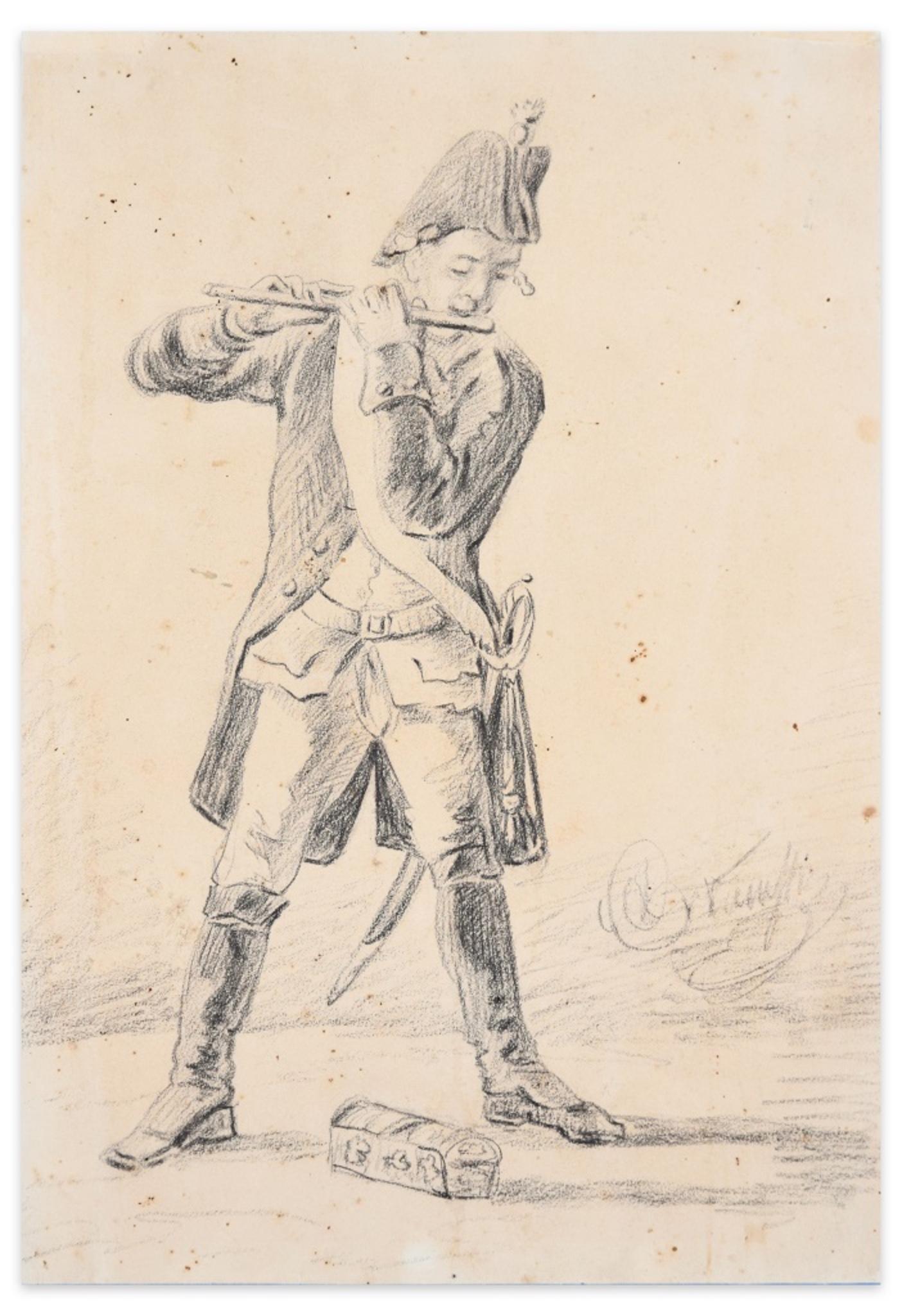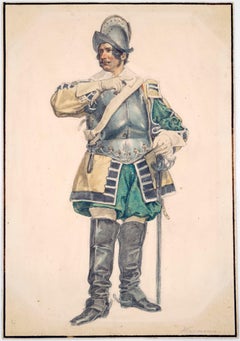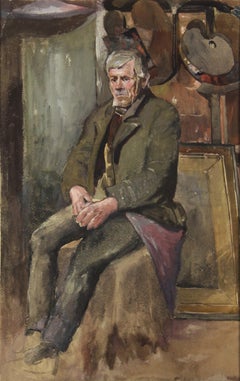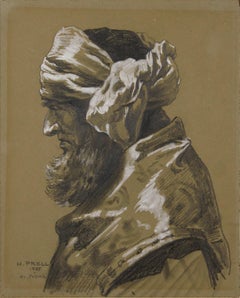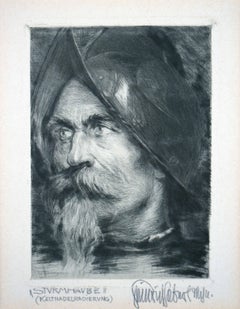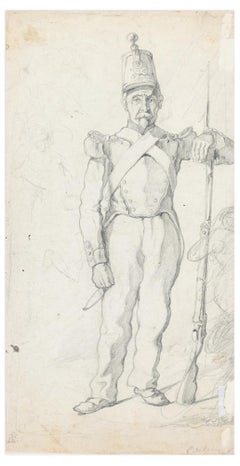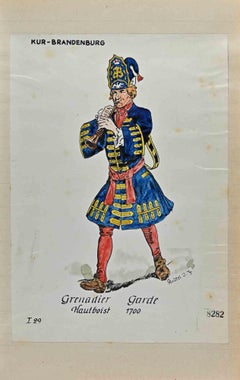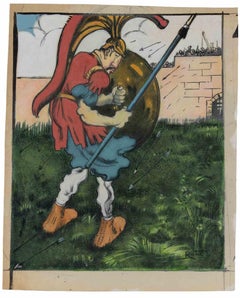Items Similar to The actor Karl Seydelmann as soldier / - The expressiveness of a simple pose -
Want more images or videos?
Request additional images or videos from the seller
1 of 4
Theodor HosemannThe actor Karl Seydelmann as soldier / - The expressiveness of a simple pose -c. 1840
c. 1840
$685.01
£513.28
€580
CA$961.82
A$1,054.13
CHF 550.49
MX$12,648.34
NOK 6,912.30
SEK 6,511.13
DKK 4,417.74
About the Item
Theodor Hosemann (1807 Brandenburg - 1875 Berlin), The actor Karl Seydelmann as soldier, around 1840. Watercolor in pencil, 22 cm (height) x 14.7 cm (width), signed “Th.[eodor] Hosemann. f.[ecit]” in pencil lower right.
- Paper somewhat darkened, dusty, with slight traces of creasing and remnants of mounting in upper margin. The image itself in vibrant colors and good condition.
- The expressiveness of a simple pose -
Possibly portraying a character from Friedrich Schiller's "Wallenstein," the actor Karl Seydelmann, armed with musket and sword, gazes into the distance. His body is frontal, with his left arm resting at his side, giving the figure a sense of power emphasized by the weapons and at the same time expressing his determination to face the enemy. The musket held aloft is analogous to a flagpole, and the willingness to fight seems to be motivated by the posture shown. The flaming "signal red" that dramatizes the stance fits in with this.
The expressiveness of the depiction is fed by simple, almost everyday gestures, revealing the 'new realism' that links Seydelmann's play with Hosemann's art. The mastery of Hosemann's expressive realism is concentrated in the 'speaking' physiognomy.
About the artist
Theodor Hosemann worked for the "Lithografische Anstalt Arnz & Winckelmann" in Düsseldorf from 1819 until he was twelve years old. From 1822 to 1828 he also studied at the Düsseldorf Academy of Art, where he was a pupil of Wilhelm Schadow from 1826. In 1828, Johann Christian Winckelmann separated from his business partners, the brothers Heinrich and Josef Arnz, and opened the publishing house "Winckelmann & Söhne" in Berlin, specializing in picture and children's books. Theodor Hosemann followed Winckelmann to Berlin as an illustrator for the publisher, where he quickly made a name for himself and also worked for George Gropius' "Bunte Hefte" from 1830. From 1834 to 1852 he worked with the sharp-tongued humorist Adolf Glaßbrenner, who published under the name Adolf Brennglas, and created illustrations for his series "Berlin, wie es ist und - trinkt" (Berlin, as it is and - drinks), "Berliner Volksleben" (Berlin People's Life), and "Komischer Volkskalender" (Comic People's Calendar). From 1842 to 1855 Hosemann was a member of the renowned Berlin literary society "Tunnel über der Spree", where he was known as "[William] Hogarth" for his now mainly humorous illustrations. In 1857 Hosemann was appointed professor at the Berlin Academy, where Heinrich Zille was one of his students in 1874.
Theodor Hosemann's oeuvre includes numerous drawings and about 6000 graphic works. He also worked as a painter. His most important book illustrations include the writings of E.T.A. Hoffmann, the fairy tales of Hans-Christian Andersen, and the adventures of Baron Münchhausen.
"Pre-march Berlin found in him its most faithful chronicler and illustrator; and if he had not created more than his pictures of Berlin folk life, his memory could not be extinguished, and anyone who wants to understand the history of our city in those years must also have Hosemann's depictions at hand - the best pictorial chronicle of those years!
Publications of the Society for the History of Berlin, September 1897
GERMAN VERSION
Theodor Hosemann (1807 Brandenburg - 1875 Berlin), Der Schauspieler Karl Seydelmann als Landsknecht, um 1840. Aquarell mit Bleistift, 22 cm (Höhe) x 14,7 cm (Breite), rechts unten in Blei mit „Th.[eodor] Hosemann. f.[ecit]“ signiert.
- Papier etwas nachgedunkelt, angestaubt, mit leichteren Knickspuren und am oberen Rand mit Montageresten. Die Darstellung selbst in kräftigen Farben und gutem Zustand.
- Die Ausdrucksstärke der einfachen Pose -
Möglicherweise eine Figur aus Friedrich Schillers „Wallenstein“ verkörpernd, blickt der mit Muskete und Degen gerüstete Schauspieler Karl Seydelmann in die Ferne. Dabei ist sein Körper mit dem in die Seite gestützten linken Arm bildfrontal ausgerichtet, was der Figur eine von den Waffen unterstrichene Machtfülle verleiht und zugleich seine Entschlossenheit, sich dem Feid zu stellen, zum Ausdruck bringt. Dabei tritt die in die Höhe gehaltene Muskete in Analogie zu einer Fahnenstange, wodurch die Kampfbereitschaft als von der zur Schau getragenen Gesinnung motiviert erscheint. Dazu passt das die Haltung dramatisierende flammende ‚Signalrot‘.
Die Ausdrucksstärke der Darstellung speist sich aus einfachen, beinahe alltäglichen Gesten, worin sich der ‚neue Realismus‘ zeigt, der Seydelmanns Spiel mit Hosemanns Kunst verbindet. Die Meisterschaft von Hosemanns ausdrucksstarkem Realismus konzentriert sich in der ‚sprechenden‘ Physiognomie.
zum Künstler
Bereits als Zwölfjähriger war Theodor Hosemann ab 1819 für die „Lithografische Anstalt Arnz & Winckelmann“ in Düsseldorf tätig. Von 1822 bis 1828 studierte er zudem an der Düsseldorfer Kunstakademie und war dort ab 1826 Schüler Wilhelm Schadows. 1828 trennte sich Johann Christian Winckelmann von seinen Geschäftspartnern, den Brüdern Heinrich und Josef Arnz, und eröffnete in Berlin den auf Bilderbögen und Kinderbücher spezialisierten Verlag „Winckelmann & Söhne“. Theodor Hosemann folgte Winckelmann als Verlagszeichner nach Berlin, wo er sich schnell einen Namen machte und ab 1830 auch für George Gropius „Bunte Hefte“ tätig war. Von 1834 bis 1852 arbeitete er mit dem scharfzüngigen Humoristen Adolf Glaßbrenner zusammen, der seine Publikationen unter dem Namen Adolf Brennglas veröffentlichte, und schuf Illustrationen für dessen Reihe „Berlin wie es ist und – trinkt“, das „Berliner Volksleben“ und den „Komischen Volkskalender“. Von 1842 bis 1855 war Hosemann Mitglied des renommierten Berliner Literatenvereins „Tunnel über der Spree“, wo er aufgrund seiner nunmehr vor allem humoristischen Bilden den Vereinsnamen „[William] Hogarth“ trug. 1857 wurde Hosemann als Professor an die Berliner Akademie berufen, wo 1874 Heinrich Zille zu seinen Schülern gehörte.
Theodor Hosemanns Oeuvre umfasst zahlreiche Zeichnungen und etwa 6000 graphische Werke. Darüber hinaus war er auch als Maler tätig. Zu seinen bedeutendsten Buchillustrationen zählen die Schriften E. T. A. Hoffmanns, die Märchen Hans-Christian Andersens und die Abenteuer des Baron Münchhausen.
„Das vormärzliche Berlin hat in ihm seinen getreuesten Chronisten und Schilderer gefunden; und hätte er nicht mehr geschaffen als seine Bilder aus dem Berliner Volksleben, sein Andenken könnte nicht verlöschen, und jeder, der die Geschichte unserer Stadt in jenen Zeiten recht verstehen will, muß auch die Schilderungen Hosemanns zur Hand nehmen – die beste Bilderchronik jener Jahre!“
Schriften des Vereins für die Geschichte Berlins, September 1897
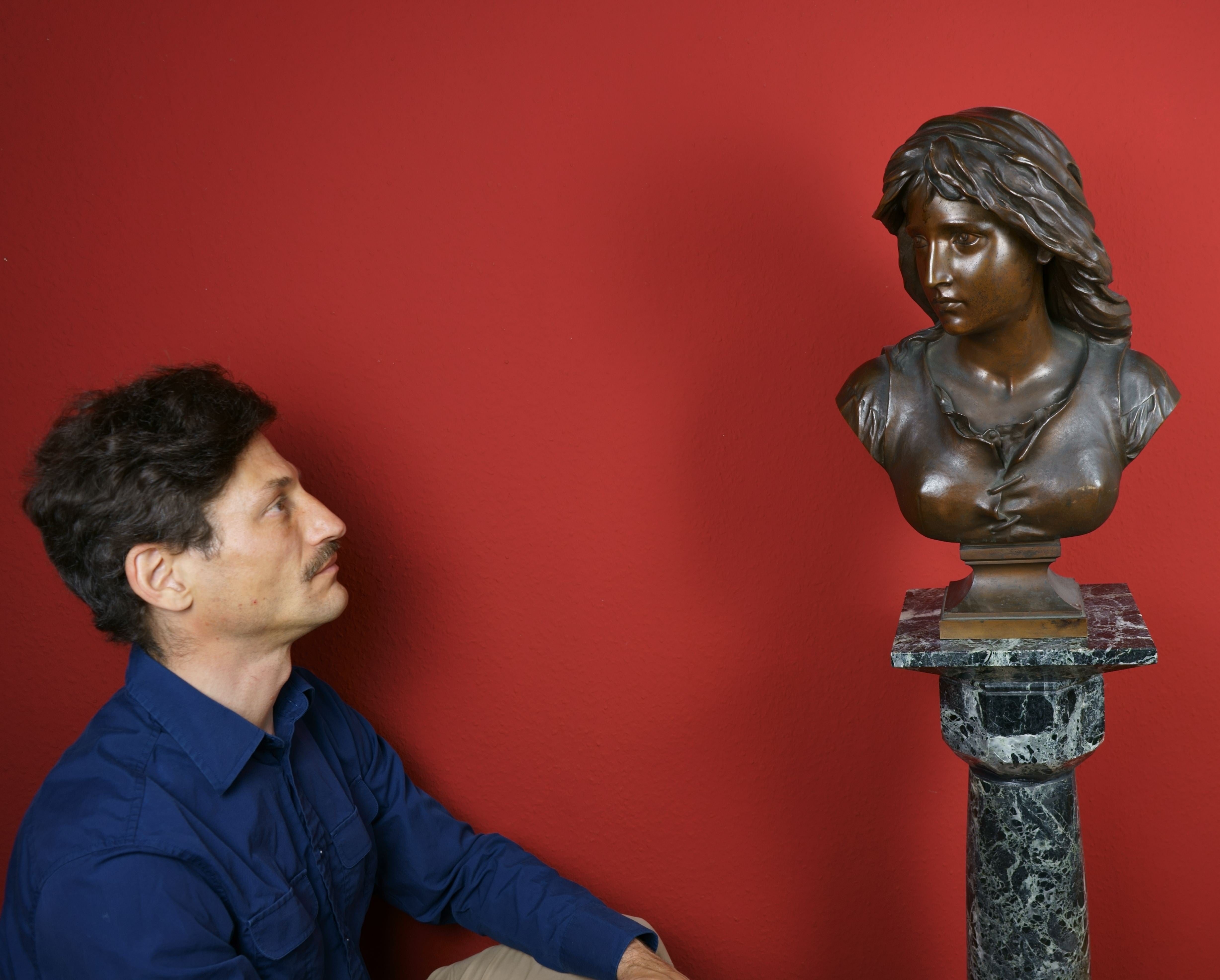
About the Seller
5.0
Vetted Professional Seller
Every seller passes strict standards for authenticity and reliability
Established in 2014
1stDibs seller since 2023
21 sales on 1stDibs
- ShippingRetrieving quote...Shipping from: Berlin, Germany
- Return Policy
Authenticity Guarantee
In the unlikely event there’s an issue with an item’s authenticity, contact us within 1 year for a full refund. DetailsMoney-Back Guarantee
If your item is not as described, is damaged in transit, or does not arrive, contact us within 7 days for a full refund. Details24-Hour Cancellation
You have a 24-hour grace period in which to reconsider your purchase, with no questions asked.Vetted Professional Sellers
Our world-class sellers must adhere to strict standards for service and quality, maintaining the integrity of our listings.Price-Match Guarantee
If you find that a seller listed the same item for a lower price elsewhere, we’ll match it.Trusted Global Delivery
Our best-in-class carrier network provides specialized shipping options worldwide, including custom delivery.More From This Seller
View AllThe actor Karl Seydelmann, probably as Max Piccolomini / - Theatrical Realism -
Located in Berlin, DE
Theodor Hosemann (1807 Brandenburg - 1875 Berlin), The actor Karl Seydelmann probably as Max Piccolomini, around 1840. Watercolor with pencil, 20.5 cm (height) x 14.7 cm (width), sig...
Category
1840s Realist Figurative Drawings and Watercolors
Materials
Paper
Man sitting in the studio - Thinking about art -
Located in Berlin, DE
Adolph Eduard Otto von Faber du Faur (1828 Ludwigsburg - 1901 Munich). Man sitting in the studio. Watercolour painting, 43 x 27 cm (visible size), 73 x 53 cm (frame), monogrammed at lower right, estate stamp.
Upper right corner neatly repaired, small tear in the wall to the left of the sitter.
- Thinking about art -
About the artwork
The sitter, an elderly man, is seated in a studio on a pedestal reminiscent of an academy hall. The earthy, dark tones give the scene a weighty quality. The lightest tones are found in the incarnate parts of the figure, which do not stand out from the other colours of the picture, but are linked to them. As a result, the sitter's face is both part of and the highlight of the colour references in the picture. The colour of the sitter's skin is reflected in his pink coat, while his white-grey hair matches the colour of the wall next to him. This almost monochrome wall surface, in turn, is connected across the portrait to the framed picture standing on the floor, which seems to have been erased by this correspondence with the empty wall surface. Through the palette, which is positioned directly behind the sitter's head, the reference to painting, which is already given by the studio space, is explicitly linked to the sitter, who thus seems to be contemplating the question of the meaning of art.
This raises the question of whether Faber Du Faur, who had become lonely in his old age, might have painted a self-portrait here in his later years. In addition to the studio setting, the sitter's explicit reference to the palette and the fact that the picture was part of his estate, the only summary elaboration of the body suggests a self-portrait, while the representation of the face is concretised with the wide-open eyes typical of a self-portrait. This concentration on the face gives the impression of the artist's melancholy introspection, captured by the palette and related to the meaning of painting, whose dark character is reinforced by the concealment of the palette hanging on the right of the picture in the light tones so characteristic of Faber Du Faur. In the course of this resignation, Faber du Faur advises his son Hans, who has also become a painter: "Promise me one thing: never move to Munich, they'll kill you here!"
Whoever the sitter may be, the references to painting make the portrait a resigned self-contemplation by Faber Du Faur, focused on art.
About the artist
After leaving school, Otto Faber du Faur entered the service of the Württemberg army, at the same time cultivating his artistic talent. In 1851, on the recommendation of his father Christian Wilhelm, who was himself a battle painter, he spent six months in Munich as an apprentice to Alexander von Kotzebue. In 1852 he was granted a year's leave of absence from military service to study battle painting in the studio of Adolphe Yvon...
Category
1890s Realist Portrait Drawings and Watercolors
Materials
Watercolor
$897 Sale Price
20% Off
Half-length portrait of a Pharisee - In the shadow of betrayal -
Located in Berlin, DE
Hermann Prell (1854 Leipzig - 1922 Dresden-Loschwitz). Half-length portrait of a Pharisee, 1885. Sketch for the right-hand figure in the painting Judas Iscariot, 1886. Pencil drawing heightened with opaque white and black chalk on beige-grey wove paper (papier vélin), 34 x 27.8 cm (visible size), 52 x 45 cm (mount), signed, dated and inscribed "H. PRELL 1885 zu 'Judas'".
Minor browning, collection stamp on the reverse.
- In the shadow of betrayal -
About the artwork
This painting is the sketch for the head of the Pharisee offering the coins to Judas in one of Herrmann Prell's major works, the painting Betrayal of Judas, completed in 1886. The painting belongs to the Staatliche Kunstsammlungen Dresden and is illustrated in Adolf Rosenberg: Prell, Bielefeld and Leipzig 1901, p. 21 (Fig. 19). It is especially highlighted in Thieme-Becker (vol. 27, p. 376).
Hermann Prell, Betrayal of Judas, 1886
The monumental head, which fills the picture and is distinguished by its ornamented robe, is almost a lost profile, which in the executed painting is justified by the Pharisee's turning towards Judas. Despite the fact that the sitter withdraws from the viewer by turning away, it was necessary to artistically elaborate the motivation for the purchase of one of Christ's disciples, which is why the drawing focuses on the expression of the face, while the 'accessories' are treated in a more summary manner.
In characterising the face, Hermann Prell performs a balancing act: since the Pharisee, despite his destructive actions, is an actor in the history of salvation, the head must show a dignity appropriate to the event, but at the same time the physiognomy must also bear witness to the scheming attitude that led to the betrayal. To solve this dilemma, Prell draws on the traditional depictions of the heads of the apostles, shading the face to indicate the obdurate darkness of the spirit and moving the base of the nose slightly upwards while the mouth falls away, thus giving a physiognomic expression to the motivation of the action. The fatal drama of the betrayal is expressed in the monumentalisation of the head and in the thunderous white highlights that contrast with the darkness of the chalk.
As a study, considered by the artist to be a work in itself, this drawing reveals the pictorial problems and brainstorming of monumental painting.
About the artist
In 1872 Prell, who was one of the most important exponents of monumental painting of his time, began studying painting with Theodor Grosse at the Dresden Academy of Art and continued with Carl Gussow at the Berlin Academy in 1876. Hans von Marées taught him in Rome in 1878. More influential on his work, however, were Arnold Böcklin and Max Klinger, with whom Prell had been friends since his student days and with whom he worked together on several occasions.
Prell's first major work, which established his reputation as a monumental painter, were the frescoes in the banqueting hall of the Architektenhaus in Berlin in 1881/82, commissioned by the state and depicting the different periods of architecture. Prell then went to Italy for two years to study fresco painting. Other major commissions followed. These included monumental frescoes in the town halls of Worms (1884), Hildesheim (1882-92), Gdansk (1895) and Dresden, the staircase of the Silesian Museum of Fine Arts in Breslau (1893/94), the throne room of the German Embassy in Rome (1896-99) and the staircase of the Albertinum in Dresden (1900-1904).
From 1886 Prell taught at the academy of arts in Berlin and in 1892 he was appointed professor at the academy of arts in Dresden. His students included Osmar Schindler and Hans Unger...
Category
1880s Realist Figurative Drawings and Watercolors
Materials
Chalk
$1,422 Sale Price
20% Off
Balaclava - The target in sight -
Located in Berlin, DE
Heinrich Haberl (1869 Passau to 1934 Munich), Sturmhaube, c. 1900. drypoint, 14 x 10 cm (platemark), 28 x 21 cm (sheet size), 39 x 29 cm (passe-partout), titled "Sturmhaube" in lead at lower left and inscribed "Kaltnadelradierung", signed and locally inscribed "Heinrich Haberl Mchn. [Munich]" at lower right, inscribed again in lead on verso and with old collection stamp.
- slightly darkened, fixed and mounted
- The target in sight -
About the artwork
The theatrical "role-portrait" is to be seen against the background of the Rembrandt cult, which reached its climax at the end of the 19th century. The soldier seems to have stepped straight out of Rembrandt's Night Watch (1642) to fix something outside the picture with an alert and ready gaze. The steeply rising brim of the morion frames the gaze and thus perspectivises it as the actual 'pictorial action'. The gaze represents both the vigilant defence and the visionary goal of the battle.
Not only the subject, but also the style of the etching needle reflect Rembrandt's understanding of the times. Strong contrasts of light and dark are created in a virtuoso free stroke, without losing the effect of the reflections on the helmet and in the eyes. This shows a kinship with the early prints of Lovis Corinth, who also saw himself as an artist in the role of the knight. Against this background, Haberl's picture can also be seen as a representation of his artistic self-image.
About the artist
Heinrich Haberl first attended the art school in Nuremberg and from 1892 studied at the Munich Academy. There he was a master student of Johann Leonhard von Raab, Rudolf von Seitz, Franz von Defregger...
Category
Early 19th Century Realist Figurative Prints
Materials
Etching
$226 Sale Price
20% Off
Study with Torso, Hands, and Umbrella - The characteristic of the inconspicuous
Located in Berlin, DE
Paul Friedrich Meyerheim (1842 Berlin - 1915 ibid.). Sketch of a female torso with hands and an umbrella. Pencil on paper, 27.5 x 22.5 cm (visible size)...
Category
1890s Realist Figurative Drawings and Watercolors
Materials
Pencil
Self-portrait - Homo nudus -
Located in Berlin, DE
Bruno Paul (1874 Seifhennersdorf - 1968 Berlin). Self-portrait, c. 1895. Pencil on paper, mounted on cardboard, 53.5 x 35 cm, signed 'Paul' at upper left.
- Homo nudus -
About the artwork
In a mirrored situation, Bruno Paul looks at himself in the picture. While his body, which is the size of the format, is shown in profile parallel to the picture, he turns his head into the picture in order to become aware of himself there, whereby the lighter use...
Category
1890s Realist Figurative Drawings and Watercolors
Materials
Pencil
$3,306 Sale Price
20% Off
You May Also Like
Soldier - Original Pencil Drawing by an Unknown French Artist - 19th Century
Located in Roma, IT
Soldier is an original artwork realized by an Anonymous French artist in the first decades of the XIX Century.
Original pencil drawing. The sheet is drawed also on the back. Hand-s...
Category
19th Century Modern Figurative Drawings and Watercolors
Materials
Pencil
Grenadier Guards in Kur-Brandenburg in 1700 - Drawing By Herbert Knotel - 1940s
Located in Roma, IT
Grenadier Guards is an original drawing in ink and watercolor realized by Herbert Knotel in 1930/40s.
Good condition except for being aged.
The artw...
Category
1940s Modern Figurative Drawings and Watercolors
Materials
Ink, Watercolor
Paysan Centenaire, Soldat de l'Armée du Général Kosenisko by Franciszek Tepa
By Franciszek Tepa
Located in London, GB
SOLD UNFRAMED
Paysan Centenaire, Soldat de l'Armée du Général Kosenisko by Franciszek Tepa (1829-1889)
Watercolour
26.3 x 30 cm (10 ⅜ x 11 ¾ inches)
Initialed and dated lower left, ...
Category
1870s Realist Portrait Drawings and Watercolors
Materials
Watercolor
The Brave Soldier - Drawing by Gabriele Galantara - Early 20th Century
By Gabriele Galantara
Located in Roma, IT
The brave soldier is a modern artwork realized by Gabriele Galantara (1865-1937) in the early 20th century.
Watercolor, ink. and pencil on paper. Hand signed on the right margin.
G...
Category
Early 20th Century Modern Figurative Drawings and Watercolors
Materials
Paper, Ink, Watercolor, Pencil
Member of the Military Band - Drawing - 19th Century
Located in Roma, IT
Member of the military band is a beautiful pencil drawing on cream-colored paper, realized during the XIX century by an Italian Master.
Hand-signed on the right side of the artwork....
Category
19th Century Old Masters Figurative Drawings and Watercolors
Materials
Pencil
Soldier - Ink and Watercolor - Early 20th Century
Located in Roma, IT
Soldier is an original watercolor painting realized by an Anonymous artist.
In good condition except for diffused foxing and the trace of glue on the margins.
Sheet Dimention: 26 x...
Category
Early 20th Century Modern Figurative Drawings and Watercolors
Materials
Watercolor, Ink
More Ways To Browse
Simple Painting
Art Simple Paintings
Antique Musket
Antique Flagpoles
Glasgow Girls
Great Lakes Freighter
Henri Blanc
Henry William Standing
J R Burgess
Jeux Olympique
Mednyanszky Laszlo
Meier Theo
Mexican Folk Art Painting Amate Paper
Norman Rockwell Pencil Drawings
Paul Nicholls
Paul Norton
Paul Thek
Pieter Lastman
